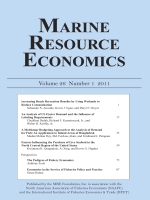In response to concerns about the morbidity rate associated with the consumption of raw Gulf of Mexico oysters, California initiated a program in March 1991 that required anyone selling raw Gulf oysters to notify potential consumers that the “consumption of raw oysters can cause serious illness and death among people with liver disease, chronic illness, or weakened immune systems.” This labeling requirement, followed shortly thereafter by similar requirements in other states, received extensive media coverage. The primary objective of this study was to consider, within the context of a complete demand system, the impact of mandatory warning labels and associated media attention on the demand for the product subject to regulation and media attention (i.e., Gulf product) as well as substitute products. Results indicate that warning labels lowered the demand for oysters originating from the Gulf and Chesapeake and increased demand for oysters originating from the Pacific and foreign sources. Results also indicate that the own-price flexibilities from all sources are inelastic and, with few exceptions, all products are gross substitutes for one another.
JEL Classification Code: Q18, Q58





